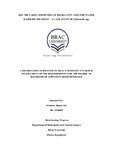Are the lakes and rivers of Dhaka city safe for water-based recreation? A case study of Salmonella spp.

View/Open
Date
2019-04Publisher
Brac UniversityAuthor
Ovi, Al Imran AhmedMetadata
Show full item recordAbstract
Unplanned urbanization, defective sewerage system and lack of public concern can result in contamination of surface water bodies. As these water bodies are a major part of diurnal and recreational activities, contamination may possess a huge health risk. The purpose of this particular case study is to observe the presence and responses of Salmonella spp. in such water bodies contaminated with industrial and household pollutants. To carry out the study, two of the largest water bodies of Dhaka city (Gulshan lake and Buriganga river) were chosen. A total of 40 water samples were aseptically collected from Gulshan Lake and 40 samples from Buriganga River from November 2017 to February 2018. Then the samples were processed for isolation of culturable Salmonella, followed by checking for Salmonella specific virulence gene invA. After that, ten randomly selected strains from each sources were checked for their susceptibility to an array of eight antibiotics. After that, three strains based on their antibiogram pattern from each sources were tested for survival potential under starvation stress. During the study period, 75% of the sample collected from the lake and 82.5% of the sample collected from the river yielded culturable Salmonella of which 76.6% isolates from the lake and 60.6% isolates from the river contained invA gene. The antibiogram revealed that all the isolates from both Buriganga and Gulshan showed complete resistance to amoxicillin, 90% isolates from Buriganga showed resistance to chlorpheniramine while 80% of the isolates from Gulshan showed complete resistance to chlorpheniramine. Around 60% isolates from Buriganga showed an intermediate result against co-trimoxazole. The survival patterns between the lake and river showed slight difference but both showed a gradual decrease in culturable count over the time. Finally, an observation of static biofilm formation showed that isolates from both of the sources form biofilm in adverse environment but biofilm formed by the isolates from Gulshan Lake remain more viable over time. The study reveals that both Buriganga River and Gulshan Lake can be endemically contaminated with potentially pathogenic Salmonella.
